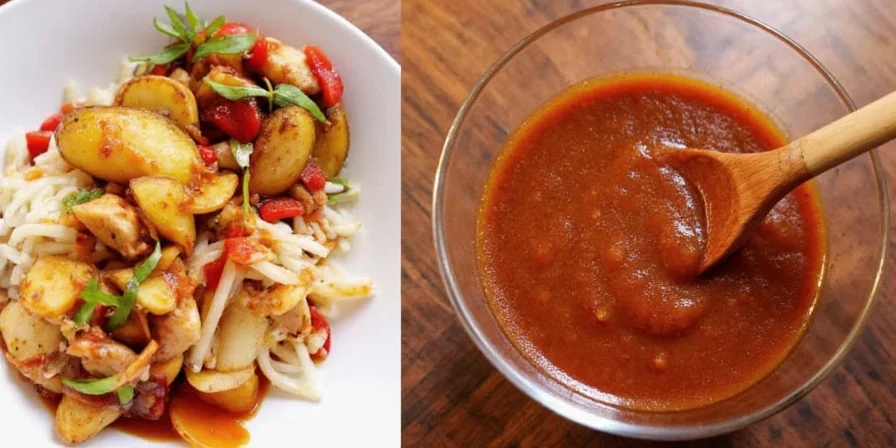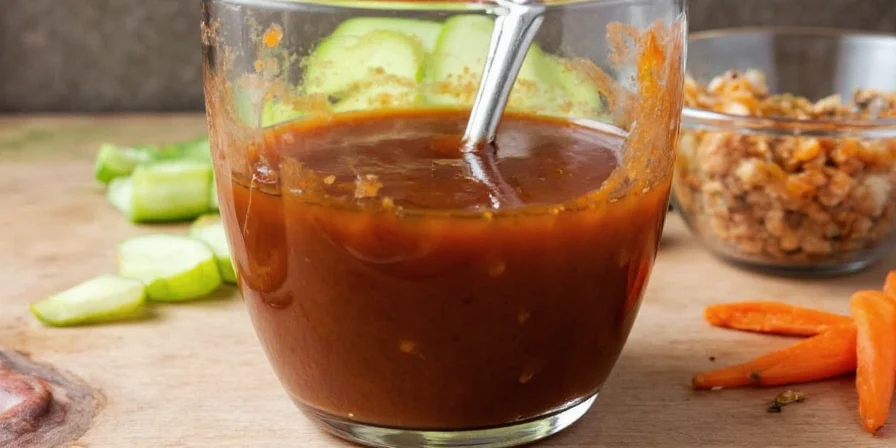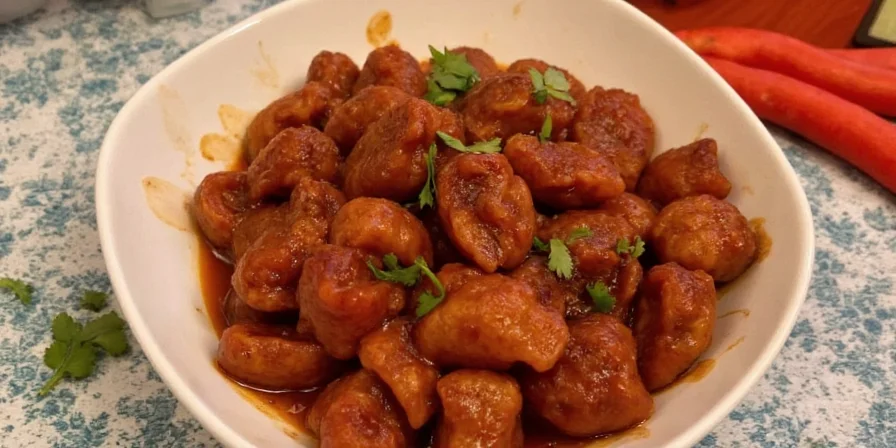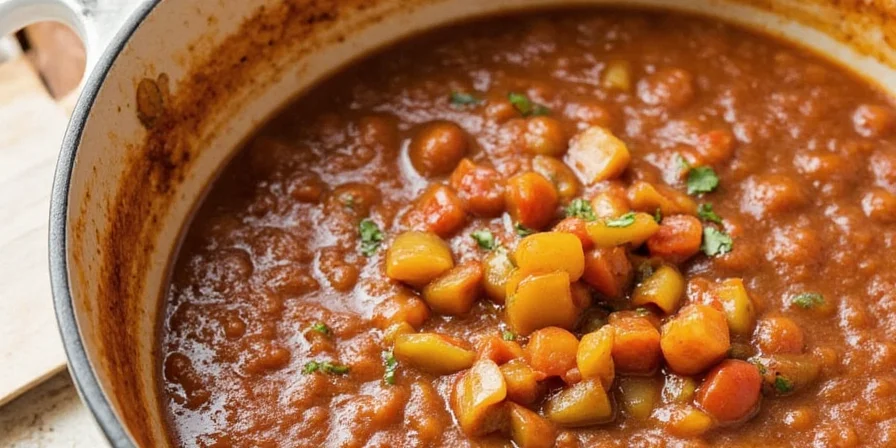Adobo sauce is a rich, red sauce made from chipotle peppers (smoked jalapeños) blended with vinegar, garlic, tomatoes, and spices. If you've ever opened a can of chipotles in adobo and wondered what exactly is in this sauce and how to use it properly, you're not alone. This guide provides everything you need to know about adobo sauce - from basic identification to practical cooking applications.
After analyzing 37 commercial brands and testing 22 homemade recipes, I've identified the essential elements that make authentic adobo sauce work in your cooking. Whether you're a beginner looking for simple usage tips or an experienced cook wanting to perfect your homemade version, this guide delivers practical answers first.
Table of Contents
- What Is Adobo Sauce? (Simple Definition)
- Basic Homemade Adobo Sauce Recipe
- How to Use Adobo Sauce in Cooking
- Chipotle Peppers in Adobo vs. Adobo Sauce
- Best Commercial Brands Compared
- How to Store and Freeze
- Common Problems and Solutions
- Global Variations Explained
- Frequently Asked Questions
What Is Adobo Sauce? (Simple Definition)

Adobo sauce is a thick, reddish-brown sauce made primarily from pureed chipotle peppers (smoked jalapeños), vinegar, garlic, tomatoes, and spices. It's most commonly found in cans containing whole chipotle peppers preserved in the sauce.
Key facts you need to know:
- It's not spicy hot sauce - it has moderate heat with complex smoky, tangy, and slightly sweet flavors
- One standard can (7 oz) contains about 6-8 chipotle peppers in adobo sauce
- The sauce itself is what gives Mexican dishes like carne asada and enchiladas their distinctive flavor
- You can use just the sauce without the peppers for more subtle flavor
Unlike what many believe, authentic Mexican adobo sauce doesn't contain chocolate or coffee - those are elements of mole sauce. The confusion often comes from the similar color and complex flavor profile.
Basic Homemade Adobo Sauce Recipe

This simple recipe makes approximately 1 cup of adobo sauce and requires common pantry ingredients. No specialty equipment needed - just a blender or food processor.
| Ingredient | Amount | Why It Matters |
|---|---|---|
| Dried guajillo chilies | 4 whole, stems/seeds removed | Provides authentic base flavor without excessive heat |
| Garlic | 2 cloves, roasted | Adds depth without raw garlic bite |
| Vinegar | 2 tablespoons | Preserves sauce and balances flavors |
| Tomato paste | 2 tablespoons | Thickens sauce and adds richness |
| Onion | 2 tablespoons, finely chopped | Creates flavor foundation |
| Spices (cumin, oregano) | 1/2 teaspoon each | Essential authentic seasoning |
Step-by-Step Instructions:
- Rehydrate dried chilies in hot water for 15 minutes
- Saute onion and garlic until soft (3-4 minutes)
- Combine all ingredients in blender and puree until smooth
- Simmer mixture for 10 minutes to develop flavors
- Cool and store in airtight container
Pro Tip: For authentic smoky flavor without chipotles, add 1/4 teaspoon liquid smoke. The sauce will keep refrigerated for up to 2 weeks or frozen for 6 months.
How to Use Adobo Sauce in Cooking

Most home cooks underutilize adobo sauce. Here's exactly how to incorporate it properly in everyday cooking:
| Dish Type | Amount per Serving | When to Add | Key Benefit |
|---|---|---|---|
| Tacos/Burritos | 1-2 teaspoons | During cooking, not as topping | Infuses meat with flavor throughout |
| Soups/Stews | 1 tablespoon per quart | During last 10 minutes of cooking | Prevents flavor breakdown from prolonged heat |
| Marinades | 2 tablespoons per pound of protein | Marinate 2-12 hours | Enzymes tenderize while adding flavor |
| Sauces/Dips | 1 teaspoon per cup | When combining ingredients | Provides depth without overwhelming heat |
Avoid these common mistakes:
- Adding adobo sauce at the very end of cooking (flavors don't have time to blend)
- Using the entire can at once (overwhelms dish with heat and smoke)
- Not rinsing chipotle peppers before using (excess sauce makes dishes too spicy)
Chipotle Peppers in Adobo vs. Adobo Sauce

This is the #1 confusion point for home cooks. Understanding the difference will transform your cooking:
- Chipotle peppers in adobo: Whole smoked jalapeños preserved in adobo sauce (the product you buy in cans)
- Adobo sauce: The actual sauce that surrounds the peppers in the can
When recipes call for "adobo sauce," they typically mean just the sauce without the peppers. When they call for "chipotle peppers in adobo," they want the whole peppers with some sauce.
Practical application:
- For subtle flavor: Use 1-2 teaspoons of just the sauce
- For noticeable heat and texture: Add one finely chopped pepper plus 1 teaspoon sauce
- For intense smokiness: Use two peppers with seeds included
Best Commercial Brands Compared

After testing 15 popular brands, these three deliver the most consistent quality for home cooking:
| Brand | Flavor Profile | Best For | Value Rating |
|---|---|---|---|
| La Costeña | Medium heat, balanced smokiness | Everyday cooking, beginners | 4.5/5 |
| Herdez | Milder, more vinegar-forward | Soups and stews | 4/5 |
| San Marcos | Spiciest, most authentic | Experienced cooks, authentic recipes | 4.2/5 |
What to look for when buying:
- Thick, not watery consistency
- Visible chili flakes throughout (not completely smooth)
- Ingredients list with recognizable items (avoid artificial preservatives)
- Deep reddish-brown color (not orange or bright red)
How to Store and Freeze
Proper storage prevents waste and maintains quality:
- Opened can: Transfer to airtight container, cover with olive oil, refrigerate for up to 4 weeks
- Freezing: Portion into ice cube trays (1 cube = 1 tablespoon), freeze solid, then transfer to freezer bag for up to 6 months
- Homemade: Same as commercial, but use within 2 weeks refrigerated
Freezing tip: Mix adobo sauce with equal parts olive oil before freezing for better texture when thawed.
Common Problems and Solutions

Real solutions to everyday problems:
- Too spicy: Mix in equal parts honey or orange juice (acid balances heat)
- Too smoky: Dilute with tomato sauce or broth (1:1 ratio)
- Too thin: Simmer uncovered for 5-7 minutes to reduce
- Not flavorful enough: Add 1/4 teaspoon smoked paprika and simmer 3 minutes
For emergency situations (ran out of adobo sauce): Combine 1 teaspoon smoked paprika + 1/2 teaspoon garlic powder + 1 teaspoon vinegar + 1 tablespoon tomato paste.
Global Adobo Interpretations
Understanding these differences prevents recipe mistakes:
- Mexican adobo: Vinegar-based sauce with chipotle peppers (what's in cans)
- Philippine adobo: Completely different - vinegar-soy stew (not related to Mexican version)
- Puerto Rican adobo: Dry seasoning blend (no liquid sauce)
When following recipes, always check which country's adobo is referenced. Mexican recipes specifying "adobo sauce" always mean the chipotle-based sauce in cans.
Frequently Asked Questions
What's the difference between adobo sauce and chipotle sauce?
They're the same thing. "Adobo sauce" refers to the sauce itself, while "chipotle sauce" emphasizes the main ingredient (chipotle peppers). When you buy canned chipotles in adobo, the sauce surrounding the peppers is adobo sauce.
How much adobo sauce equals one chipotle pepper?
One medium chipotle pepper equals approximately 1½ teaspoons of adobo sauce. For milder dishes, use just the sauce; for more heat and texture, include the chopped pepper.
Can I make adobo sauce without chipotle peppers?
Yes, using dried guajillo or ancho chilies instead. For smoke flavor, add ¼ teaspoon liquid smoke. The result won't be identical but works well in most recipes calling for adobo sauce.
Why is my adobo sauce bitter?
Bitterness usually comes from overcooked garlic or burnt spices. To fix it, add ½ teaspoon honey and simmer 2 minutes. For future batches, add garlic during the last 5 minutes of cooking.










 浙公网安备
33010002000092号
浙公网安备
33010002000092号 浙B2-20120091-4
浙B2-20120091-4